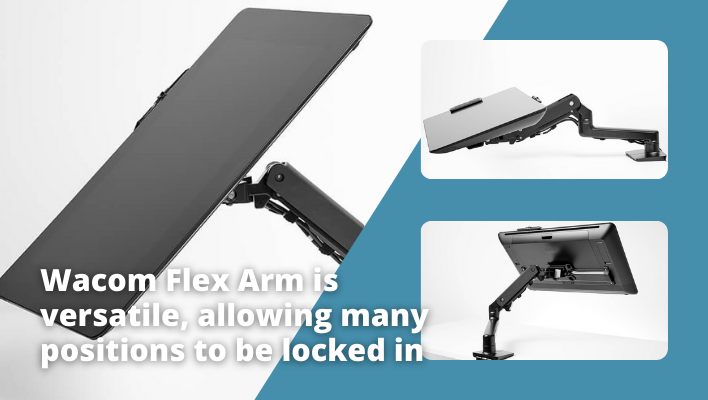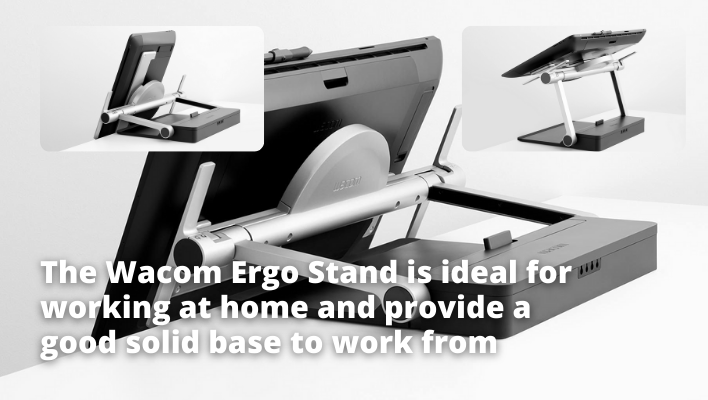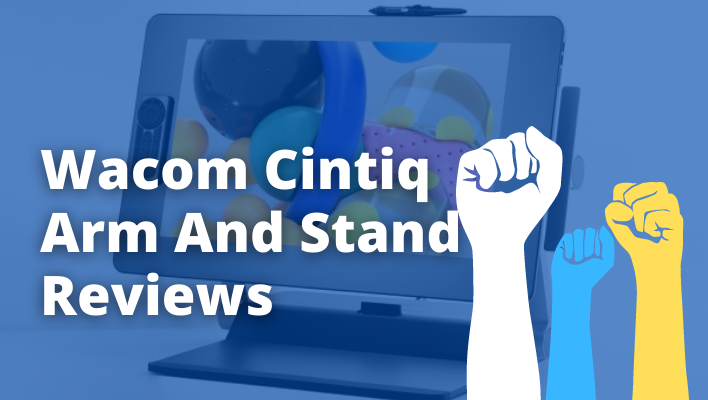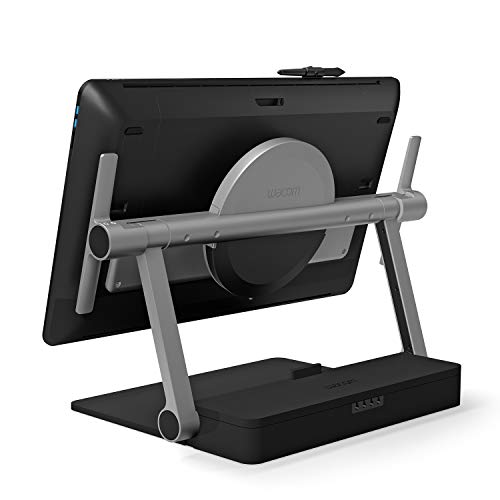In this post, we will review the best drawing tablet arms on the market. Drawing tablet arm products have become increasingly popular in recent years as more and more artists are using them to get a better drawing experience.
This article provides reviews of some of these products so that you can determine which is the right one for your needs.
Lets start with a quick review of the best Cintiq arms.
Let’s now look at the best models of drawing tablet arms we could find for sale at the moment. Unfortunately, the truth is that there are not many to choose from that are specifically for Wacom graphics tablets.
Wacom have 2 items, the Flex Arm and the Ergo Stand which are designed for their Cintiq Pro 24 and 32 models. If you are looking for an arm for your Wacom One, you might be out of luck or trying to shoehorn it into something generic – not ideal!
Wacom Flex Arm review
- For comfortable drawing and working
- Ultimate FLEXIBILITY in positioning and placement
- Reaches across 30” desk
Wacom Flex Arm with cable management is the perfect way to declutter your home or study space. Whether you’re mounting it on a desk, edge of the table, or free-floating for maximum flexibility and comfort.
- Mounts to desk for easy access or free floats.
- Supports heavy weight during use.
- Easily moves around for ultimate creative flexibility.
- Keeps your workspace tidy with a clean cable management system.
- Give yourself the freedom to move around when you’re feeling stuck in one position.
As the name suggests, the Wacom Flex Arm is a flexible drawing tablet arm. It is compatible with the Cintiq Pro 24 and 32 models and will extend to around 32 inches from the clamp.
As an artist, I was looking for a product that would help me position my computer comfortably in relation to my drawing table and allow me to draw as if it were right there on top of the surface while still keeping all cables out of sight.
The installation process is simple, it clamps to the back of the desk, but you can’t drill it into the desk. The clamp is tightened using a hex-key and some people have complained about the weak screws Wacom supply. But it does feel sturdy and able to support the heavy Cintiq 32 Pro easily.
Note that this arm is only compatible with the newest Cintiq Pro models, not the older Cintiq 22HD. The arm is also not designed to be attached to a wall and can’t support different “heads” such as a VESA mount. However, you can buy a Wacom Cintiq VESA mount separately (again only for the Pro 24 and 32 models) and then use any monitor arm you like.
Just to add to the confusion the Wacom VESA adapter is not compatible with their own Flex Arm.
But, if you are lucky to own one of the 2 Cintiq Pro models, then this is the arm for you!

Alternative arms
Some people recommend using an Ergotron arm to hold their Cintiq.
- To use with the Samsung 49" Odyssey G9, it is...
- Heavy-duty monitor arm lets you easily reposition...
- Holds screens 20 to 42 pounds (9 to 19 kilograms)...
- Offers 23.6 inches (60 centimeters) of extension...
Ergotron make standard monitor arms with a clamp on the back of your desk. However, to use a Cintiq Pro, you would need to also buy the Wacom Cintiq VESA mount. Without this, you would not be able to connect to a standard monitor arm.
Another thing to consider when using a 3rd party monitor arm is the weight. The Cintiq Pro devices are quite heavy:
- Cintiq Pro 24 = 16 lbs
- Cintiq Pro 32 = 30 lbs
Most monitor arms support around 20 lbs, so you would need to buy a heavy duty version such as the Ergotron HX to support the Pro 32.
One drawback of using a standard monitor arm to support your pen display is that they are not designed to be flexible. The Wacom Flex Arm provides many different degrees of movement, whereas a monitor arm is designed to be more static. The mounting pole allows for you to pull the monitor or screen closer to you but you may struggle to adjust the tilt and angle without resorting to finding that Allen Key.
Wacom Ergo Stand Review
The Ergo stand is not an arm and should be seen as an alternative option. Ideally, you will need a lot of room on your desk for this stand.
The Cintiq is mounted to the stand and can then be tilted forwards and backwards or even rotated. The arms on the stand are also long enough for the Cintiq to hang over the edge of your table. This gives you a good, flexible drawing surface that can be customized to how you like to draw.
The Ergo Stand is designed to fit Wacom’s Cintiq Pro drawing display tablet. There are 2 different models, depending on which Cintiq size you get:
- Only compatible with Cintiq Pro 24 (DTK2420,...
- Raise, tilt and rotate your Cintiq Pro 24 into the...
- Creates a comfortable, stable surface on which to...
- Rotate your Cintiq Pro to draw at a fresh angle...
- ACK62802K
For me, using a stand gives a better surface to use my Cintiq on. I always found the Flex Arm to have a slight amount of “give” or “bounce”. With the Ergo stand on the desk, you are guaranteed that it won’t move whilst you are using it. It locks well in place and is easy to adjust. However, you do have to sacrifice some desk space in order to use it.
Some people complain that it is an expensive accessory on top of an already expensive Cintiq. The Cintiq Pro comes with some small flip-out legs, but they will only allow a 20 degree angle and can’t be adjusted. If you are not happy with the Cintiq Pro as it comes, you will need to invest in a stand or arm.

What is a drawing tablet arm?
A drawing tablet arm is a device that attaches to your desk and holds up the Cintiq drawing tablet. This makes it easier for artists to move their hands back and forth without losing contact with the device, which can happen when they are using only a wrist rest as support.
The arm also allows you to rotate the drawing tablet so that it is easier to draw at an angle, or you can use the arm to hold up a laptop if needs be. The arms pivot and bend, allowing you to position and lock-in the graphics tablet at the perfect angle for you.
When you don’t need to use the drawing tablet arm, it folds up and out of the way, leaving you more space on your desk.
They are mainly used to support the Wacom Cintiq pen display tablets.
What should a good drawing tablet arm be made from?
The best drawing tablet arms should be made of high-quality materials and have durable stands for holding your device securely in place. They also need to be easy to assemble and move around without breaking anything else.
A drawing tablet arm should not be made of flimsy plastic or materials that bend too easily. When it comes to build quality or material, the best drawing tablet arms are usually metal because they have a sturdier base than other materials and won’t break as quickly if something falls on them. The straps for holding your tablets in place need to be durable too.
Most arms come with a specialist hole patterns for screws, straps or a VESA mount, designed for the specific drawing tablet. The Wacom Flex-Arm is only compatible with their Cintiq range, so make sure the arm you buy is designed for your make of drawing tablets, or is universal.
It is worth noting that most models of drawing tablet arm do not use a standard monitor mount.
How to secure a drawing tablet arm to the desk
The drawing tablets arm should attach to the desk with a clamp that will hold it tightly in place. This is usually achieved with two screws, which are tightened from underneath the table surface. One screw attaches firmly into the back of your drawing tablet and holds onto its edge by pulling it tight against the other side of this clip.
However, this will mean that you need a desk that is compatible with this installation process and has enough free “edge” for the clamp to fit.
If you use a monitor arm, you will have the same issue. Some don’t clamp firmly to the desk.
Some arms will also allow them to be connected under the desk, so the drawing tablets are positioned in front of you, in your lap.
The arm will also contain some cable management functions, allowing you to safely stow away any cables, keeping it looking pretty. Some tablets suffer from having too many cables connected which can get in the way. With these cable tidy clips and straps, the wires will never be a problem again.
Check out this video that demonstrates how to set up the Wacom Flex Arm and attach it securely to your desk:
What are the drawbacks of using a drawing tablet arm?
The main drawback is that Wacom only make arms for certain models of display tablet – the Cintiq Pro 24 and Cintiq Pro 32.
These are the more expensive models of tablet made by Wacom and the Flex Arm is quite expensive.
So if you are looking for a generic or universal model to hold your Wacom graphics tablet, you are going to be disappointed.
Less desk space for your drawing tablets. You will need to find a spot that is not being used for the clamp, which can be difficult in some cases. This may mean you have less room on your keyboard tray or never use a pen at all when drawing (an unfortunate consequence).
The products can be expensive. Some people don’t like the idea of spending upwards of $100 on a drawing tablet arm.
Some are cheaply made, and can break easily, so make sure you buy one with good build quality. Your tablet is expensive too and you don’t want it to crash on the floor when the arm fails.
Many customers find that their arms do not work well with desks or monitors because they come loose too easy. Sometimes the clamps are not tight enough to support continued movement of the tablet.
How to use your new drawing tablet arm?
Drawing tablet arms can be used in a number of ways. Some people like to attach their drawing arm underneath the desk, while others prefer attaching it on top.
The best way to determine which option is better for you is by looking at how your workspace and monitor are currently set up, then deciding if there will be any obstructions that stop you from using the product in this way.
The hinges on the arm allow you to easily move it around, and the clamp is great for ensuring that you do not have to hold it in place.
Now that the tablet is clamped in place, it should be at a comfortable drawing position for you. You can adjust the height of your arm to match how high or low you like to work on things.
Be sure to test out different heights before committing! This might be the time to convert to a standing desk!
Do you need an arm for a drawing tablet?
No. There are other options available, such as a drawing tablet stand.
A drawing tablet stand will allow you to position your device at the right angle for drawing. The stands sit on the desk and have a lockable hinge, or adjustable legs to alter the angle. You can sit the tablets on the stand and use it very naturally.
Products like the Wacom Cintiq already have legs attached that allow you to raise the back giving a more angled feel. However, a tablet stand will allow you a greater amount of freedom to choose the best angle for you.
However, an arm is more ergonomic than a drawing tablet stand because it allows you to use your hands in their natural position when using pen or pencil tool. The tablet stand will only let you make a certain amount of adjustment, so you may not find the ideal position.
What angle should a drawing tablet arm be at?
A drawing tablet arm should be at the same angle as your drawing hand. This is typically around an 80 degree angle and differs depending on how you would like to hold it, but the best thing to do is experiment with different angles until you find one that feels natural for you.
The angle will be different for left-handed and right-handed people.
Drawing tablet arms come in a variety of lengths depending on the size of your drawing area, so make sure you measure before ordering one instead of just assuming it will be long enough because most are around six feet which is plenty for an artist with a regular sized table.
Give your body some time to get used to using the arm. Many artists find that it takes a few days for their arm to adjust before they start drawing comfortably, so don’t give up if you think it feels weird at first.
This video from Wacom shows you how to set up the Wacom Ergo Stand including where to feed the cables to allow full rotation and angle adjustment:
Summary
If you’re looking for a way to help you increase your productivity, the Cintiq Flex Arm can be an excellent addition to any workstation. Its sleek design and versatility allow it to fit into most setups without creating too much clutter or taking up too much space.
Plus, with its built-in cable management system, wire organization becomes easier than ever before!
We hope this review has helped you make a decision about whether or not the Flex Arm is right for your needs. Whether you’re using it as part of a home office setup or in conjunction with other monitors so that more people can collaborate on projects simultaneously, the Wacom Cintiq Flex Arm provides enough flexibility to meet your needs.
But, if you are working more from home, the Wacom Ergo Stand may be a better option for you. It is more portable, cheaper and just as convenient to use as the arm.





